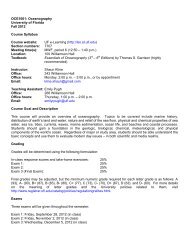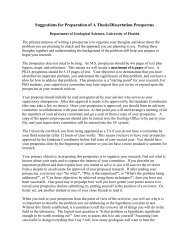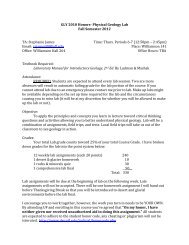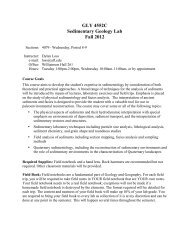Barletta et al 2010.pdf - Department of Geological Sciences ...
Barletta et al 2010.pdf - Department of Geological Sciences ...
Barletta et al 2010.pdf - Department of Geological Sciences ...
You also want an ePaper? Increase the reach of your titles
YUMPU automatically turns print PDFs into web optimized ePapers that Google loves.
2316<br />
F. <strong>Barl<strong>et</strong>ta</strong> <strong>et</strong> <strong>al</strong>. / Quaternary Science Reviews 29 (2010) 2315e2324<br />
Fig. 1. (A) Location <strong>of</strong> Core 650 (this study) sampling site. Also illustrated is the location <strong>of</strong> Cores 05, 06 and 803 from the Chukchi and the Beaufort Seas (<strong>Barl<strong>et</strong>ta</strong> <strong>et</strong> <strong>al</strong>., 2008; Lisé-<br />
Pronovost <strong>et</strong> <strong>al</strong>., 2009). The position <strong>of</strong> the North Magn<strong>et</strong>ic Pole (NMP) as d<strong>et</strong>ermined by a joint Canada-France expedition in 2001 is indicated (Newitt <strong>et</strong> <strong>al</strong>., 2002). The box in the<br />
ins<strong>et</strong> shows the location <strong>of</strong> the study area. (B) Location <strong>of</strong> the glob<strong>al</strong> direction<strong>al</strong> p<strong>al</strong>eomagn<strong>et</strong>ic data compilation from sedimentary sequences and (C) from archeomagn<strong>et</strong>ism used to<br />
constrain the CALS7k.2 model (modified from Korte <strong>et</strong> <strong>al</strong>., 2005). The d<strong>et</strong>ails <strong>of</strong> the compilation are presented in Korte <strong>et</strong> <strong>al</strong>. (2005).<br />
postglaci<strong>al</strong> sedimentary sequences collected from both the Arctic<br />
Alaskan and Canadian margins are characterized by higher sedimentation<br />
rates than in the rest <strong>of</strong> the centr<strong>al</strong> Arctic basin (e.g.,<br />
Darby <strong>et</strong> <strong>al</strong>., 2006, 2009; Rochon <strong>et</strong> <strong>al</strong>., 2006; Bringué, 2009).<br />
Holocene average sedimentation rates were estimated to vary<br />
b<strong>et</strong>ween 10 and 300 cm/ka (e.g., Andrews and Dunhill, 2004;<br />
Keigwin <strong>et</strong> <strong>al</strong>., 2006; Rochon <strong>et</strong> <strong>al</strong>., 2006; <strong>Barl<strong>et</strong>ta</strong> <strong>et</strong> <strong>al</strong>., 2008;<br />
Lisé-Pronovost <strong>et</strong> <strong>al</strong>., 2009) thus <strong>of</strong>fering the opportunity to<br />
reconstruct centenni<strong>al</strong>- to millenni<strong>al</strong>-sc<strong>al</strong>e geomagn<strong>et</strong>ic field<br />
variations in the Arctic (e.g., <strong>Barl<strong>et</strong>ta</strong> <strong>et</strong> <strong>al</strong>., 2008; Lisé-Pronovost<br />
<strong>et</strong> <strong>al</strong>., 2009). Moreover, due to the proximity <strong>of</strong> the North<br />
Magn<strong>et</strong>ic Pole (NMP; Fig. 1), sedimentary sequences from western<br />
Canadian Arctic have the advantage <strong>of</strong> recording higher amplitude<br />
PSV direction<strong>al</strong> changes than the rest <strong>of</strong> the Earth.<br />
Fig. 1B and C illustrate the location <strong>of</strong> the glob<strong>al</strong> compilation <strong>of</strong><br />
direction<strong>al</strong> p<strong>al</strong>eomagn<strong>et</strong>ic and archeomagn<strong>et</strong>ic data, respectively,<br />
used to constrain the CALS7k.2 model (Korte <strong>et</strong> <strong>al</strong>., 2005). The<br />
direction<strong>al</strong> datas<strong>et</strong> used in the CALS7k.2 model is mainly derived<br />
from lacustrine sedimentary sequences and archaeologic<strong>al</strong> artefacts<br />
or volcanic rocks from the Northern Hemisphere.<br />
Table 1<br />
Coordinates <strong>of</strong> the core.<br />
Core Latitude ( N) Longitude ( W) Water depth (m) Length (m)<br />
2004-804-650 71 .18.52 0 131 36.98 0 246 6.08<br />
3. Materi<strong>al</strong>s and m<strong>et</strong>hods<br />
Core 650 was collected on board the Canadian Coast Guard<br />
Icebreaker (CCGS) Amundsen during the 2004 Canadian Arctic<br />
Shelf Expedition Study (CASES). The core sections were split,<br />
described on board and then sampled with u-channel samples<br />
(u-shaped plastic liners <strong>of</strong> 2 2 cm cross-section and length up to<br />
1.5 m) for p<strong>al</strong>eomagn<strong>et</strong>ic an<strong>al</strong>yses. Apart from hysteresis properties<br />
and grain size an<strong>al</strong>yses, <strong>al</strong>l magn<strong>et</strong>ic remanences as well as<br />
the low-field magn<strong>et</strong>ic susceptibility (k LF ) measurements were<br />
carried out at the University <strong>of</strong> Florida (Gainesville, FL) using a 2G<br />
Enterprises Model 760R cryogenic magn<strong>et</strong>om<strong>et</strong>er and a pulse<br />
magn<strong>et</strong>izer for the induction <strong>of</strong> isotherm<strong>al</strong> remanent magn<strong>et</strong>izations.<br />
The continuous p<strong>al</strong>eomagn<strong>et</strong>ic measurements were performed<br />
at 1 cm interv<strong>al</strong>s. Non<strong>et</strong>heless, due to the response<br />
function <strong>of</strong> the magn<strong>et</strong>om<strong>et</strong>er’s pick-up coils each measurement<br />
integrates across a w4.5 cm stratigraphic interv<strong>al</strong> (Weeks <strong>et</strong> <strong>al</strong>.,<br />
1993). Therefore, the data from the upper and lower 4 cm <strong>of</strong><br />
each u-channel were not used in order to eliminate edge effects<br />
(i.e., the integration <strong>of</strong> “no sediment” at the end and the beginning<br />
<strong>of</strong> each u-channel).<br />
3.1. Magn<strong>et</strong>ic measurements<br />
U-channel samples were subjected to stepwise <strong>al</strong>ternating field<br />
(AF) demagn<strong>et</strong>ization <strong>of</strong> the natur<strong>al</strong> remanent magn<strong>et</strong>ization







